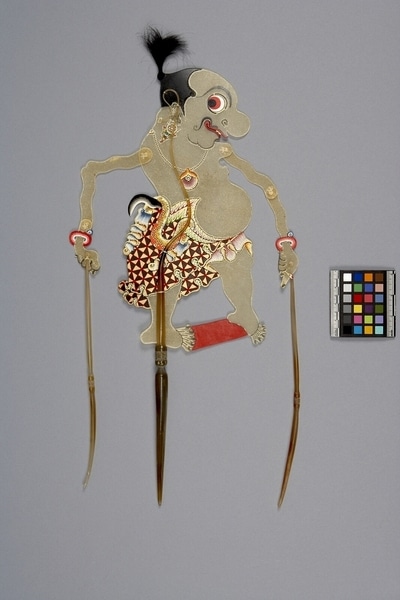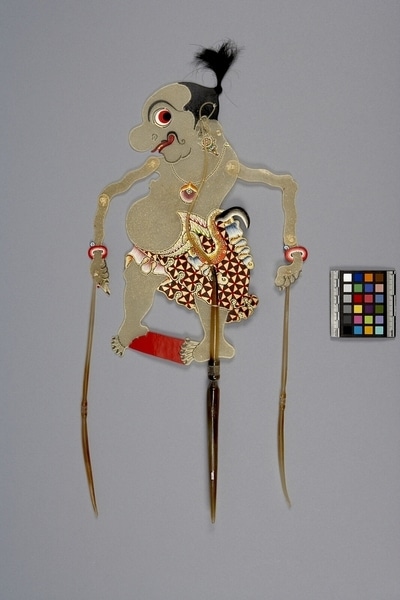Shadow Puppet Item Number: 1568/3 from the MOA: University of British Columbia


Description
Gareng shadow puppet character. Two dimensional, tall, thin man with articulated shoulders and elbows; arms have rods of horn from hands; another long, horn rod has central split and goes up height of puppet on both sides. Man is of a translucent skin with opaque painted decorations of shoes, bracelets, skirt, necklace, earrings, and facial features. Decorations are painted on both sides. Skirt is of a black and gold triangle design with red outlines; waist has a row of red and green alternating triangles above a row of green and gold triangles; fringe is in orange, blue, and white; another section of edging is orange and white with a gold vine design along it. Small tuft of dark hair protrudes upwards from back of head.
History Of Use
Wayang kulit shadow play is over 1000 years old. It is thought to be derived from the leather shadow puppetry traditions of southern India, like tholu bommalata, which came to Java with the spread of Hinduism in the first millennium. In Java - part of the largely Islamic Republic of Indonesia - this highly distinctive form of shadow puppetry is valued as a pusaka, a sacred treasure of the royal court of Yogyakarta. They are inspired by the Indian epics, the Ramayana and the Mahabharata, as well as stories of the history and folklore of Java, with a local spin. The plays are performed to mark special occasions such as birthdays, marriages, and religious events. Wayang shadow puppetry was inscribed on UNESCO's List of the Intangible Cultural Heritage of Humanity in 2008 (from Shadows, Strings & Other Things, 2019).
Item History
- Made by Pak Sagio (Maker) in Yogyakarta, Java, Indonesia before 1993
- Owned by Dominique Major before January 25, 1993
- Received from Dominique Major (Seller) and Museum of Anthropology Shop Volunteers (Funding source) on January 25, 1993
What
- Name
- Shadow Puppet
- Identification Number
- 1568/3
- Type of Item
- puppet
- Material
- water buffalo skin, hair, paint and water buffalo horn
- Overall
- height 58.0 cm, width 23.0 cm, depth 2.3 cm
Who
- Culture
- Javanese
- Creator
- Pak Sagio (Maker)
- Previous Owner
- Dominique Major
- Received from
- Dominique Major (Seller) and Museum of Anthropology Shop Volunteers (Funding source)
Where
- Holding Institution
- MOA: University of British Columbia
- Made in
- Yogyakarta, Java, Indonesia
When
- Creation Date
- before 1993
- Ownership Date
- before January 25, 1993
- Acquisition Date
- on January 25, 1993
Other
- Condition
- excellent
- Accession Number
- 1568/0003